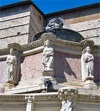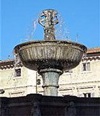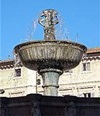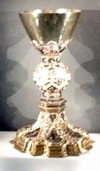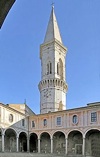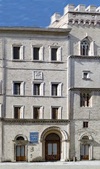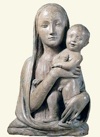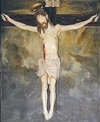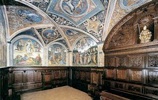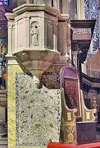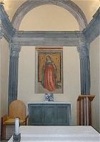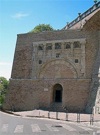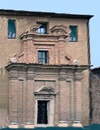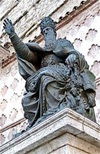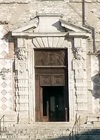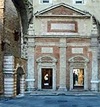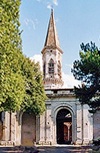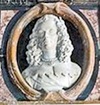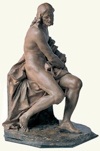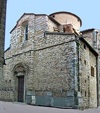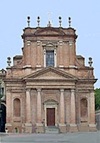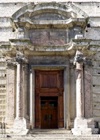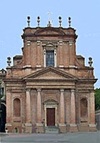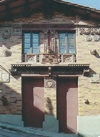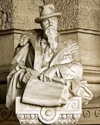Nicola Pisano (died ca. 1284) and Giovanni Pisano (died ca. 1315)
Nicola: from Apulia, then Pisa; Giovanni: from Pisa, then Siena
The masterpieces of this father and son were, respectively:
-
✴the pulpit (1255-60) in the baptistery of Pisa; and
-
✴the pulpit (1302-10) of the Duomo, Pisa.
They worked together on the Fontana Maggiore, Perugia in 1277-8, just before Nicola’s death.
Arnolfo di Cambio (died 1302)
From Colle Val d'Elsa, near Siena
Arnolfo di Cambio was probably the leading artist of his day. He is first documented in Rome in 1277, in the employment of King Charles d’ Anjou. His first documented work was on the Fontana Minore in Perugia in 1277-81. The surviving fragments in the Galleria Nazionale include this figure of a thirsty woman at the fountain.
Fra Bevignate (died after 1306)
Probably from Cingoli, based in Perugia
Fra Bevignate was Director of Works in Perugia for some 30 years until his death. He is best remembered for his role in the construction of the Fontana Maggiore (1277-8), illustrated here.
Rubeus (late 13th/ early 14th century)
Probably based in Perugia
Two important bronze sculptures in Umbria are signed by a man called Rubeus:
-
✴the bronze upper basin (1277) of the Fontana Maggiore, Perugia (illustrated here); and
-
✴the bronze architrave (late 13th century) of the Porta di Postierla of the Duomo, Orvieto.
Since both of these projects can be linked to Fra. Bevignate, it is possible that Rubeus, like Fra. Bevignate, was based in Perugia at this time. Bronze statues (1274) of a lion and a griffin that are in the Galleria Nazionale are attributed to him.
Ambrogio Maitani (died after 1346)
From Siena, based in Perugia from ca. 1317
Ambrogio Maitani, the brother of the more famous Lorenzo Maitani (above), was the city architect of Perugia in 1317-46. His most important work there was the extension of the Palazzo dei Priori (illustrated here) to provide accommodation for the Priors and the Capitano del Popolo. Although he is not documented as a sculptor, a number of works of sculpture in Perugia are attributed to him, including:
-
✴the figures of the patron saints of Perugia above the entrance to the Palazzo dei Priori (now in the Galleria Nazionale); and
-
✴the monument to Pope Benedict XI in San Domenico Vecchio (later recomposed in San Domenico).
Matteo di Giovannello, il Gattapone (died after 1374)
Il Gattapone was documented in 1374 as “generalis offitialis operum cictadelle” on the construction of the Fortezza di Porta Sole (1372-5) for the papal legate Gérard du Puy. The large cloister (ca. 1375) of Santa Giuliana is attributed to il Gattapone on stylistic grounds: this face on one of the capitals of the columns here might be a self-portrait.
Ugolino di Vieri (died ca. 1380)
From Siena
The goldsmith Ugolino di Vieri is best known for the Reliquary of the Sacro Corporale (1337-8) in the Cappella del Corporale of the Duomo, Orvieto (illustrated here). He also signed a gilded silver paten (mid 14th century) for San Domenico, Perugia: this may be a silver paten that is now in the Galleria Nazionale.
[Temporary link to Ugolino di Vieri]
Cataluzio di Pietro da Todi (died after 1419)
Cataluzio di Pietro was a goldsmith who also played a civic role in Todi. His work is known from a signed gilded silver chalice and paten (late 14th century) from San Domenico,which is now in the Galleria Nazionale. The reliquary of St Anne (late 14th century) from San Domenico that is also now in the Galleria Nazionale is attributed to one of his followers.
Bernardo Rossellino (1409-64)
From Settignano, near Florence
Bernardo Rossellino, trained as an architect and sculptor in Florence in the 1420s. He was papal architect to Pope Pius II (1458-64), for whom (inter alia) he designed the new city of Pienza in 1459-62. Among his last works was the design of the campanile (1463-8) of San Pietro, which was based on that of the campanile of the Duomo, Pienza.
Bartolomeo di Mattiolo (died 1473)
From Torgiano, based in Perugia
Bartolomeo di Mattiolo, who was based in Perugia from at least 1437, became the leading architect in that city. He worked an many important buildings, including the Duomo, San Domenico and San Francesco. He built the Collegio di Cambio (illustrated here) with and Ludovico d’ Antonibo in 1452-6; only the ground floor retains the original architecture. He worked with Agostino di Duccio (below) on the façade (1457-62) of the Oratorio di San Bernardino. He was responsible for the outer gate of Porta di San Pietro at the time of his death, a commission that passed to Agostino di Duccio.
Agostino di Duccio (died ca. 1481)
The sculptor Agostino di Duccio moved to Perugia in 1457 and spent much of the rest of his life here. His first work in the city was the decoration of the facade of the Oratorio di San Bernardino and his last was the construction of the outer facade of Porta San Pietro. His many other surviving works in Perugia include this bust (1460s) of the Madonna and Child, which probably came from San Francesco al Prato and is now in the Galleria Nazionale.
Gasperino di Antonio (died after 1485)
From Lombardy, citizen of Perugia from 1468
Gasperino di Antonio belonged to the tradition of Lombard masons. His work in Piazza del Sopramuro (1454-83) included: an arcade of shops (1454-69) for the Confraternita di Santa Maria della Misericordia; the design of the Palazzo dell' Università (1483), which was built above it; and the adjacent Palazzo del Capitano del Popolo (1472-81), illustrated here. The design of the campanile (1465) of San Domenico is attributed to him. He also worked in the Duomo (in 1451) and in Palazzo dei Priori (in 1485).
Giuliano da Maiano (1432-90)
From Maiano, near Fiesole, based in Florence
Giuliano da Maiano, who was among the leading architects and sculptors of Florence in the 15th century, is particularly known for his woodcarving and intarsia work. He designed the choir stalls (1489-91) of the Duomo, Perugia (albeit that Domenico di Tasso completed the work after Giuliano’s death).
[Temporary link to Giuliano da Maiano]
Giovanni Tedesco (late 15th century)
Giovanni Tedesco carved three documented wooden Crucifixes in Umbria, including this one, documented in 1478, that survives in the Abbazia di San Pietro. Three similar Crucifixes in Perugia are also attributed to Giovanni Tedesco:
-
✴a Crucifix (ca. 1460) from the Convento di Monteripido, now in the Galleria Nazionale;
-
✴a Crucifix (ca. 1471) from Santa Maria dei Servi, now in Santa Maria Nuova; and
-
✴a Crucifix (1499) from Santa Maria di Monteluce, which the nuns took with them to Sant’ Erminio.
Domenico del Tasso (1440-1508)
From Florence, based in Perugia in ca. 1490-1500
Almost all of the works securely attributed to the wood carver Domenico del Tasso are or were in Perugia:
-
✴ He completed the choir stalls (1489-91) of the Duomo, Perugia after the death of their designer, Giuliano da Maiano.
-
✴Together with his sons, Francesco and Marco, he executed the wooden panelling (1490-93) of the Sala dell’ Udienza (Audience Chamber) of the Collegio del Cambio (illustrated here).
Rocco di Tommas0 (died 1529)
From Vicenza, based in Umbria in 1512-26
Works associated with Rocco di Tommaso in the Duomo include:
-
✴two pulpits (1519) by on the pillars framing the tribune; and
-
✴the bishop’s throne (1520-4), which was built by Ciancio di Pierfrancesco da Perugia to Rocco di Tommaso’s design.
Giovanni Battista Bastoni (died after 1532)
From Perugia
Giovanni Battista Bastoni executed the frames for altarpieces by Eusebio da San Giorgio (in 1509), Perugino (in 1512) and Sinibaldo Ibi (in 1528), none of which survive. He carved the choir stalls (1520-9) for the Cappella del Santo Anello in the Duomo, and was at work of those for San Francesco al Prato when he died in ca. 1532. (His sons later completed the work - see below)
[Temporary link to Giovanni Battista Bastoni]
Francesco di Guido di Virio (died 1535)
Francesco di Guido worked continuously at the Abbazia di San Pietro in the period 1506-35. He also designed the Cappella di San Tommaso da Villanova (1523) at Sant’ Agostino, illustrated here.
Antonio da Sangallo il Giovane (1484-1546)
From Florence, based in Rome
Antonio da Sangallo il Giovane was one of the leading architects in Rome, particularly after the election of Pope Paul III in 1534. He designed a new Sapienza for Cardinal Francesco Armellini in 1520, but this project was subsequently aborted. He also designed the Rocca Paolina (1540-3). The curtain wall of the fortress was added to his original design (probably against his will), but he was probably responsible for the survival of part of the Etruscan Porta Marzia, which was embedded in it (as illustrated here).
Mariotto di Paolo Sensi, il Terzuolo (died 1547)
From Gubbio
The life of il Terzuolo in Gubbio is extensively documented, but only one securely attributed example of his work as a wood carver survives: the furniture (1494-7) on the right wall of the sacristy of the Duomo of Perugia.
[Temporary link to Mariotto di Paolo Sensi, il Terzuolo]
Giacomo di Luca Maffei (16th century)
From Gubbio
In 1561, Eusebio Bastoni (below) performed an evaluation of the the organ casing of Sant’ Agostino, which had been carved by Giacomo di Luca Maffei da Gubbio. [Does it survive ?]
[Temporary link to Giacomo di Luca Maffei]
Eusebio Bastoni (died after 1568)
From Perugia
Eusebio Bastoni and his brother Girolamo were paid in 1560 for the completion of work of the choir stalls of San Francesco al Prato, which their father Giovanni Battista (above) had begun some three decades earlier. Eusebio also carved the wooden side door (1568) of the Duomo.
[Temporary link to Eusebio Bastoni]
Galeazzo Alessi (1512-72)
Galeazzo Alessi spent only two relatively short periods of his illustrious career as an architect in his native Perugia:
-
✴He worked for the papal legates in Perugia in 1542-8. His design (1548) for the church of Santa Caterina Nuova (illustrated here) belongs to this period
-
✴He returned in 1569 and spent the last three years of his life here.
His work in the first period included the design of the church and nunnery of Santa Caterina Nuova, illustrated here. His funerary monument survives in San Fiorenzo.
Giacomo Barozzi da Vignola (1507-73)
From Vignola, near Modena, based in Rome
Vignola had a very successful career in Rome, where he often worked for the papacy. He also worked in Umbria, often as an advisor, at the behest of prominent nobles with interests there. In Perugia, he designed a new chapel (1555-62) in San Francesco al Prato for Cardinal Ascanio della Corgna, which sadly no longer survives.
[Temporary link to Giacomo Barozzi da Vignola]
Vincenzo Danti (1530-76)
Vincenzo Danti began his career with the prestigious commission for the statue (1555) of Pope Julius III outside the Duomo, Perugia. He left for Florence in 1557 and enjoyed a successful career there, returning to Perugia shortly before his death.
Ludovico Scalza (died after 1578)
Ludovico Scalza was a cousin of Ippolito Scalza, the most important sculptor in Orvieto. Ludovico seems to have worked predominantly in Perugia. He worked on the Cappella della Corgna (1555-62) in San Francesco al Prato and the Altare di San Bernardino (1559-67) in the Duomo, neither of which survives. He also designed two palaces for the Baldeschi family. His last work in Perugia seems to have been on the portal in the left wall of the Duomo (1568), illustrated here, which was designed by Galeazzo Alessi (above).
Bino Sozi (died after 1604)
All of the known works of this architect are in his native Perugia. They include the design (1584) of the facade of the Maestà delle Volte.
Fiorenzo di Giuliano (died after 1608)
From Perugia
This wood carver and gilder worked mainly in his native Perugia, but little of his documented works there survive. His lost works include a magnificent gilded tabernacle (1592-1602) for the high altar of San Francesco al Prato.
[Link to Fiorenzo di Giuliano]
Carlo Maderno (1556-1629)
From Ticino, based in Rome from 1588
Carlo Maderno, who moved to Rome to work with his uncle, Domenico Fontana, became one of the leading architects of the Baroque period. His work in Umbria included advice on the rebuilding of San Domenico, Perugia in 1625-32.
Valentino Martelli (1550-1630)
Valentino Martelli, who was born in Perugia, became the city’s leading architect. He supervised the remodelling of the Abbazia di San Pietro over a long period from 1591 until his death. This photograph depicts the new entrance to the abbey that he built in 1614.
Francesco Mochi (1580-1654)
From Montevarchi (near Arezzo), based in Rome
Francesco Mochi began his career under the patronage of the Farnese family. In Perugia, he executed the tomb of Marcantonio Eugeni (died 1657) in Sant’ Agostino. The bust (ca. 1640) of the deceased from this tomb is now in the Galleria Nazionale (illustrated here). A small crucifix (17th century) that is exhibited in Palazzo della Penna is attributed to him.
Alessandro Algardi (1598-1654)
From Bologna, based in Rome
Alessandro Algardi succeeded Gianlorenzo Bernini as papal court sculptor in 1644, with the accession of Pope Innocent X. This bust (1648) from the funerary monument of Elisbetta Cantucci in San Domenico is traditionally attributed to him, although modern scholars tend to attribute it to one of his followers. A painted papier-mâché figure (17th century) of St Mary Magdalene, which is more securely attributed to him, formed part of the collection of the art historian Valentino Martinelli and is exhibited in Palazzo della Penna.
Gianlorenzo Bernini (1598-1680)
From Naples, based in Rome
Gianlorenzo Bernini was the most important sculptor in Rome for much of the 17th century. The collection of the art historian Valentini Martinelli, which is exhibited in Palazzo della Penna, includes a number of his works. These include this signed clay model (ca. 1630) of the bound Christ.
Pietro (1629-1705) & Alessandro Baglioni (died after 1734)
Pietro Baglioni and his son, Alessandro belonged to a branch of the Baglioni family. Each of them had extensive cultural interests, but they are best remembered as architects.
-
✴Pietro’s masterpiece is the design of the Oratorio di Santa Cecilia (1687-90).
-
✴Alessandro designed the centrally-planned church of Santa Teresa (illustrated here).
Carlo Murena (1713-64)
From Collalto Sabino, based in Rome
Carlo Murenatrained as an architect in Rome under Luigi Vanvitelli (below), and later looked after Vanvitelli’s practice in Rome. His first major commission, in 1740, was as director of the construction of the church and monastery of Montemorcino Nuova, to Vanvitelli’s design. He also designed the tabernacle (1761-2) for the high altar of the Duomo.
Pietro Carattoli (1703-66)
Pietro Carattoli worked extensively in Perugia of the reconstruction of a number of important buildings, including the churches of San Francesco al Prato (in 1748) and Santa Maria della Misercordia (in 1760). He also worked in fresco, often designing perspectival frameworks for scenes painted by more conventional artists. He designed the portal (1729) in the facade of the Duomo (illustrated here).
Luigi Vanvitelli (1700-73)
Based in Rome and then, from 1752, Caserta, near Naples
Luigi Vanvitelli was one of the most important Italian architects of the 18th century. He executed two projects in Perugia:
-
✴the design of the church of Montemorcino Nuovo (illustrated here) and the adjacent convent in 1740; and
-
✴the design of a new top storey for Palazzo del Capitano after the earthquake of 1741.
Stefano Cansacchi (late 18th century)
The architect Conte Stefano Cansacchi, who belonged to a noble family of Amelia, attended the Accademia del Disegno, Perugia. The church of Sant’ Agostino was largely rebuilt to his design in 1799-1803.
Alessandro Arienti (1833-96)
From Milan
Alessandro Arienti was the city architect of Perugia from 1865 until his death. He redesigned much of the city following the demolition of the Rocca paolina. His most important work here was the Palazzo del Governo (1869-72), later known as the the Palazzo della Provincia e Prefettura.
Francesco (1838-1903) & Nazareno Biscarini (1835-1907)
This page deals with the work of these two brothers:
-
✴The sculptor Francesco Biscarini was the co-founder of the Fornace Angeletti-Biscarini (illustrated here). The architectural terracottas produced here from 1858 were extremely fashionable.
-
✴The architect Nazareno Biscarini often used his brother’s work in his buildings.
Guglielmo Calderini (1837-1916)
Guglielmo Calderini was an influential architect in the newly-united Italy after 1860. He built a number of palaces in Perugia, often on a speculative basis. He also rebuilt the ancient church of San Costanzo in neo-Romanesque style in 1882-90.


